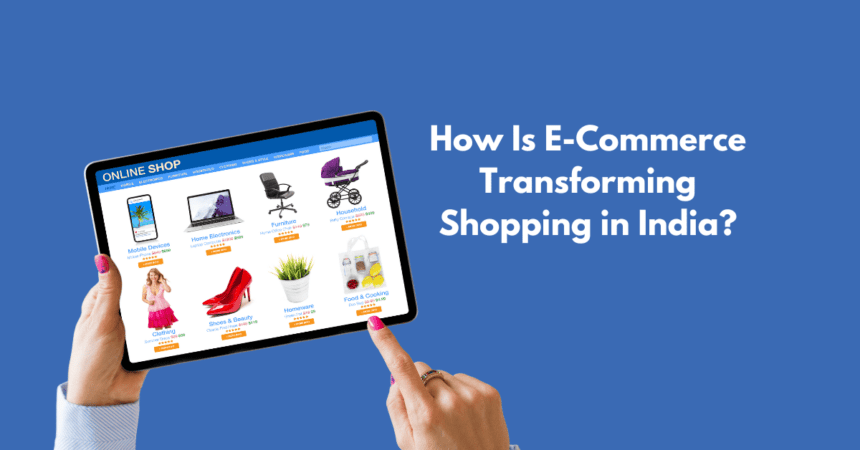Introduction
The Rise of E-Commerce in India
The Indian e-commerce sector has seen an explosive growth trajectory, transforming the way consumers shop. A nation once dominated by traditional markets and physical stores has rapidly embraced digital shopping platforms, driven by the convenience and vast selection they offer. This transformation is not just a shift in purchasing habits but a revolution in consumer behavior, fundamentally altering the marketplace.
Historical Context: Traditional Shopping to Digital Platforms
Historically, India’s retail landscape was characterized by bustling bazaars and neighborhood kirana stores. Shopping was a social activity, often involving haggling and personal interactions. However, the digital era has ushered in a new paradigm. E-commerce platforms have democratized access to goods and services, transcending geographical limitations and offering unprecedented convenience.
Changing Consumer Preferences
Convenience and Accessibility
Consumers today value the ease and accessibility that online shopping provides. With just a few clicks, a wide array of products can be delivered to their doorstep, often within a day. This convenience has redefined shopping, making it a preferred choice for many.
Impact of COVID-19 Pandemic
The COVID-19 pandemic accelerated the adoption of e-commerce, as lockdowns and social distancing measures made physical shopping challenging. Consumers turned to online platforms not only for essentials but also for a variety of products, marking a significant shift in buying habits.
Shift from Physical Stores to Online Retail
The allure of online shopping lies in its ability to save time and effort. Consumers no longer need to navigate traffic, find parking, or wait in long lines. This shift from physical stores to online retail is a testament to the growing preference for efficiency and convenience.
Technological Advancements
Role of Smartphones and Internet Penetration
The proliferation of smartphones and affordable internet has been a game-changer for e-commerce in India. With millions of users accessing the internet, online shopping has become more accessible, particularly in remote and rural areas.
Digital Payment Systems and Their Adoption

The advent of digital payment systems like UPI, mobile wallets, and online banking has facilitated seamless transactions. This ease of payment has boosted consumer confidence and spurred the growth of e-commerce.
AI and Personalization in E-Commerce
Artificial intelligence plays a pivotal role in enhancing the online shopping experience. Personalized recommendations, chatbots, and predictive analytics create a tailored shopping journey, making consumers feel valued and understood.
Demographic Influences
Young and Tech-Savvy Population
India’s demographic dividend, with a large population of young and tech-savvy individuals, has been a significant driver of e-commerce growth. This generation, comfortable with digital technologies, is leading the shift towards online shopping.
Urban vs. Rural Consumer Behavior
While urban areas have seen a rapid adoption of e-commerce, rural regions are not far behind. The increasing penetration of smartphones and internet connectivity has brought online shopping to rural consumers, bridging the urban-rural divide.
Influence of Social Media on Shopping Habits
Social media platforms have become powerful influencers of consumer behavior. From discovering new products to following trends set by influencers, social media significantly impacts purchasing decisions and preferences.
Product Categories Dominating Online Sales
Fashion and Apparel
Fashion and apparel are among the top categories driving online sales. Consumers are drawn to the vast selection, competitive pricing, and the convenience of trying on clothes at home with easy return options.
Electronics and Gadgets
The demand for electronics and gadgets has surged, with consumers seeking the latest technology and best deals online. Detailed product descriptions and reviews help in making informed purchasing decisions.
Grocery and Household Items
The online grocery segment has seen remarkable growth, especially post-pandemic. The convenience of home delivery of daily essentials has made it a popular choice among consumers.
E-Commerce Giants in India
Flipkart and Amazon: The Battle for Dominance
Flipkart and Amazon are the titans of the Indian e-commerce space, constantly vying for market share. Their competitive strategies, from exclusive product launches to massive sales events, have intensified the e-commerce boom.
The Rise of Homegrown Platforms
Homegrown platforms like Snapdeal, Myntra, and BigBasket have carved out their niches, offering localized solutions and catering to specific consumer needs. Their success stories add to the dynamic e-commerce landscape.
Influence of Global Players
Global players like Alibaba and Walmart have made significant inroads into the Indian market, bringing in investment and expertise. Their presence has further spurred competition and innovation.
Marketing Strategies
Personalization and Targeted Advertising
E-commerce companies leverage data analytics to personalize shopping experiences and target advertisements. This targeted approach ensures that consumers are presented with relevant products, enhancing their shopping journey.
Flash Sales and Discounts
Flash sales, discounts, and festive offers are effective marketing strategies to attract and retain customers. These time-limited deals create a sense of urgency, driving impulsive purchases and boosting sales.
Influencer Marketing and Brand Collaborations
Influencer marketing has become a powerful tool for e-commerce brands. Collaborations with popular influencers and celebrities help in reaching a broader audience and building brand trust.
Consumer Trust and Security Concerns
Addressing Cybersecurity Threats
With the rise of e-commerce, cybersecurity threats have also increased. E-commerce platforms invest heavily in securing their systems to protect consumer data and build trust.
Building Trust Through Reviews and Ratings
Consumer reviews and ratings play a crucial role in building trust. Positive feedback from other shoppers reassures potential buyers about the quality and reliability of products and services.
Return Policies and Customer Support
Generous return policies and robust customer support are essential for fostering consumer trust. Knowing that they can easily return products or resolve issues gives consumers confidence in their online purchases.
Impact on Traditional Retail
Decline of Brick-and-Mortar Stores
The convenience of online shopping has led to a decline in foot traffic to traditional brick-and-mortar stores. Many physical retailers are struggling to compete with the extensive offerings and lower prices of online platforms.
Hybrid Models: Combining Online and Offline Shopping
In response, some retailers are adopting hybrid models, integrating their online and offline operations. Click-and-collect services and in-store digital experiences are examples of how traditional retail is evolving.
Future of Shopping Malls
Shopping malls, once bustling centers of activity, are reimagining their role in the retail ecosystem. They are transforming into entertainment and lifestyle hubs to attract consumers who seek experiences beyond shopping.
Regulatory and Policy Changes
Government Initiatives and Support
The Indian government has introduced various initiatives to support the growth of e-commerce. Policies aimed at improving digital infrastructure and promoting ease of doing business are pivotal in this regard.
Data Protection and Privacy Laws
As e-commerce grows, so does the importance of data protection and privacy laws. Ensuring that consumer data is handled responsibly is crucial for maintaining trust and compliance with regulations.
Challenges and Opportunities for Policy Makers
Policymakers face the challenge of balancing growth with regulation. Crafting policies that foster innovation while protecting consumers will be key to sustaining the e-commerce boom.
E-Commerce and Employment
Job Creation
The e-commerce sector has emerged as a significant job creator. From technology and logistics to customer service, the industry offers diverse employment opportunities.
Gig Economy and Delivery Services
The rise of the gig economy and delivery services has created flexible job opportunities. Delivery personnel, often working as independent contractors, are a vital part of the e-commerce ecosystem.
Skill Development and Training
To sustain growth, there is a need for continuous skill development and training. E-commerce companies are investing in upskilling their workforce to keep pace with technological advancements and changing market dynamics.
Environmental Considerations
Sustainable Packaging and Green Logistics
Environmental sustainability is becoming a key concern for e-commerce companies. Many are adopting sustainable packaging solutions and green logistics practices to minimize their environmental impact.
The Carbon Footprint of E-Commerce
The carbon footprint of e-commerce, from packaging waste to transportation emissions, is a growing issue. Companies are exploring ways to reduce their carbon footprint through innovation and efficiency.
Consumer Awareness and Eco-Friendly Choices
Consumers are becoming more environmentally conscious, influencing their purchasing decisions. E-commerce platforms that offer eco-friendly products and practices are gaining favor among these conscientious shoppers.
Future Trends in E-Commerce
Voice Commerce and Virtual Shopping
Voice commerce and virtual shopping are emerging trends poised to revolutionize the e-commerce experience. Voice assistants and VR technologies offer new ways to browse and purchase products.
Expansion of Omni-Channel Retailing
Omni-channel retailing, where consumers enjoy a seamless shopping experience across multiple channels, is becoming increasingly popular. This approach integrates online and offline experiences, catering to diverse consumer preferences.
Technological Innovations on the Horizon
Technological innovations, from AI-driven analytics to blockchain, are set to further transform e-commerce. These advancements promise to enhance security, efficiency, and personalization in online shopping.
Case Studies
Success Stories of Indian E-Commerce Startups
India has witnessed numerous e-commerce success stories. Startups like Nykaa and BigBasket have disrupted traditional markets with innovative business models and customer-centric approaches.
Lessons from Failed E-Commerce Ventures
Not all ventures succeed. Analyzing failed e-commerce businesses offers valuable lessons in what works and what doesn’t in the highly competitive market.
Comparative Analysis: India vs. Global E-Commerce
Comparing the Indian e-commerce landscape with global markets reveals unique challenges and opportunities. Insights from global trends can inform strategies for sustained growth in India.
Conclusion
The Ever-Evolving E-Commerce Landscape
The e-commerce landscape in India is dynamic and continually evolving. As technology advances and consumer preferences shift, the sector will continue to adapt and grow.
Long-Term Implications for Consumer Behavior
The long-term implications of the e-commerce boom are profound. It is reshaping consumer behavior, redefining retail, and influencing economic policies.
Final Thoughts on the Future of Online Shopping in India
The future of online shopping in India is bright, with immense potential for growth and innovation. As the market matures, consumers can look forward to an ever-improving online shopping experience.
Follow Humstory for more content.













